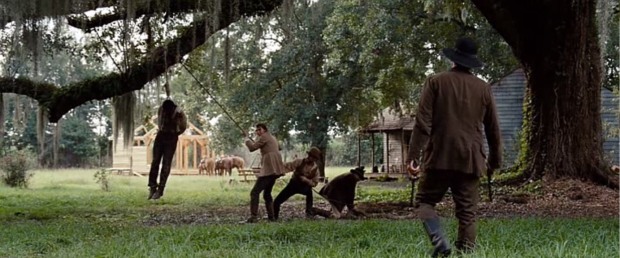Cinema’s Greatest Scenes: #3 12 Years a Slave
Every Friday I’m going to be highlighting and analysing some of cinema’s greatest scenes, or sequences depending on your definition. Some will be familiar, etched indelibly into the iconography of cinema, while others will be obscurer moments worthy of wider circulation and attention. For this week’s entry it’s the harrowing brutality of 12 Years a Slave…
* Spoilers Ahead *
The Film: 12 Years a Slave (2013)
Director: Steve McQueen
The Background: Set in the 19th century, free African American Solomon Northup (Chiwetel Ejiofor) has been kidnapped and sold into slavery. Now a working slave on a plantation in New Orleans, Northup is struggling to adapt to his new life which has led to tensions with vile carpenter Tibeats (Paul Dano).
The Scene: After continual baiting by Tibeats, Northup snaps and beats his cowardly antagonist. Tibeats retreats before bringing back reinforcements who exact revenge on Northup by hanging him from a nearby tree. We watch on as Northup swings perilously between life and death.
What Makes it Great?
As I touched on with my previous article about Sam Peckinpah and The Wild Bunch, we’re becoming increasingly desensitised to violence in our cinemas and on our TV screens. The modern deluge of violence – kill streaks on Call of Duty, annihilated cities in Batman v Superman and gratuitous fatalities in the Sons of Anarchy – has made it a truly rare event when we are genuinely shocked by brutality. 12 Years a Slave’s hanging scene is one such moment.
McQueen distances himself from traditional fast paced action and quick edits. Instead, the lynching scene is depicted in an unflinching long take that stands unbroken for well over a minute. As Northup’s feet shuffle desperately to keep him afloat, we watch on in horror waiting and hoping for a cut so we can avert our gaze. But it never comes. Instead we’re forced to face the horror. By tackling the scene in one take McQueen doesn’t give the viewer an easy way out, but he also presents a sense of realism to proceedings this way. In the real world there are no cuts or angle changes, and so Northup’s hanging blurs the lines between cinema and reality.
Similarly, the composition of the scene furthers the sense of realism. Northup hangs agonisingly close to the viewer, as if teasing us to come and save him. The use of the single take only heightens the feeling we’re somehow complicit in Northup’s suffering, looking on unable to help him. In the background of the shot slaves go about the daily plantation duties and children frolic carelessly. All are totally indifferent to the lynching, as if such violence is so frequent it’s become passé and simply the norm. The banality of such bloodshed mirrors are own modern acceptance of violence.
As the Visual Culture Blog in their excellent analysis points out, the dilapidated old shack and a new, half built, outhouse, that flank Northup, epitomise his precarious position literally hanging between life and death. The fact he’s positioned slightly to the right, in the shadows, suggests he’s nearer death than the sun basked plains deep in the back of the shot. The whole scene unfolds without a dramatic score of any kind. Only natural sounds, which for the most part amount to silence, permeate the hanging which only adds to the sense of realism.
Django Unchained, Mississippi Burning and Selma all show racial violence, but none match the raw power of 12 Years a Slave’s hanging scene. McQueen, as he did with the nihilistically beak Hunger, uses the single take shot as the basis for his own brand of shocking realism. In order to shock the viewer and imbue the scene with lasting impact, McQueen presents the hanging in the most simplistic way possible rather than the most dramatic.

